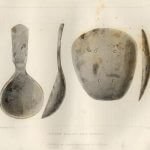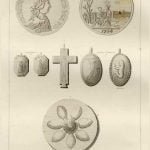Whether this was in ancient times merely an ornament, which any one might wear, or a badge of authority, it might be fruitless now to inquire. It is probable that the modern practice of conferring metallic medals on chiefs only, and of marking thereby their authority, was founded on an ancient practice of this kind existing in the original tribes.


The ancient gorget or medal of the North American tribes, was formed of the inner and shining parts of large sea-shells. The instance figured in Plate 19, Figs. 3 and 4, was taken from one of the old ossuaries of Beverly, Canada West. 1
This article is three inches across, and three and three quarter inches from top to bottom.
Another species of ancient medal or gorget of smaller size, found in their ancient places of sepulture, consisted of a circular piece of flat shell, from one and a half to two inches in diameter, quartered with double lines, having the devices of dots between them. This kind was doubly perforated in the plain of the circle. Three examples of this form of medal or badge of chieftainship are figured in Plate 25, Figs. 7, 29, and 30. The specimen figure 29 was obtained from an old grave at Upper Sandusky, Ohio; and number 30, Plate 25, from a similar position in Onondaga County, N. Y. These localities serve to show its use among diverse tribes, and prove an extensive community of the prevalent manners and customs; a point which it is important at all times to keep in view.


In connection with this subject, there is given in Plate 12, Fig. 1, the representation of an ancient British medal, obtained from the descendants of the chief to whom it was given about sixty years after its date: (1764). It will be observed that this medal, which is rudely stamped, was struck the year of the crowning of George III. It presents the boy king s head, crowned with the olive-leaf; and the inscription Georgius III, D. G. M. Bri. Fra. et Hib. Rex. F. D. shows that the ancient title of the British kings was then retained in full.
The obverse exhibits a British officer and an Indian, sitting under a tree on rolls of tobacco, shaking hands, with the motto, ” Happy while united.” The Indian has a pipe resting in his left hand. The officer has his left hand at his breast. The landscape in the background is manifestly the city and harbor of New York; as the stamp “N. York,” “D. C. F.,” “1764,” plainly denotes.
A wing crossed with a pipe, forms an appropriate figure at the top for hanging it by a ribbon.
Figures 3 and 4, Plate 20, are medals of the French period of colonization in western New York, about 1666, in the area of Onondaga County; and are irrefragable proofs of that ill-fated scheme. Fig. 2 shows small medals of an octagonal form, inscribed with the names of St. Agatha and St. Lucia, of the Romish calendar. Both are made from an alloy resembling silver. Number 4 is an ovate medal of the same period, from a leaden plate, and rudely representing, on one side, the figure of a man hanging by his arms, and a snake before it. The other side represents a man sitting. Fig. 3, Plate 20, is a crucifix of silver, of the same period.No. 5, Plate 20, represents an ancient form of gorget, figured with the heads of snakes or tortoises.
Citations:

